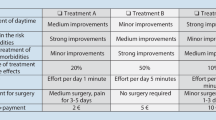Summary
Problems and side effects resulting from CPAP treatment in patients with OSAS can often be solved during therapy initiation. However, some symptoms develop several weeks or even months after treatment has started. Well-known determinants of noncompliance are the patient being comparatively only slightly overweight and lack of daytime sleepiness as well as high treatment pressure and oronasal problems. These criteria, however, correlate poorly with actual long-term compliance rates. Therefore follow-up examinations are necessary to detect non-compliant patients. Several studies have repeatedly shown high effectiveness of follow-up procedures. However, methods without sufficient evidence for wide-spread use are also being used.
High compliance is important because the usage of more than 6 hours per night can considerably improve life expectancy in OSAS patients. Measures to improve compliance of proven effectiveness are repeated sessions of education, psychosocial interventions, use of alternative treatments, prescription of a heated humidifier, changing to an alternate mask, detection of mouth leakage and treatment of persisting or reappearing daytime sleepiness.
Thus, by periodic controls an amelioration of usage time and a better cost-effectiveness ratio can be achieved with relative low expenditure.
Zusammenfassung
Zwar können viele durch die Therapie entstehenden Probleme während der Ersteinstellung von Patienten mit obstruktivem Schlafapnoesyndrom mit CPAP beseitigt werden, dennoch treten häufig erst nach einigen Wochen oder Monaten Nebenwirkungen auf, die die Therapieakzeptanz erheblich reduzieren. Einige bekannte Vorhersagekriterien einer schlechten Compliance stellen relativ geringes Übergewicht, fehlende Tagesschläfrigkeit, hohe Beatmungsdrucke sowie Nasen-Rachen-Probleme dar. Diese Vorhersagekriterien korrelieren aber zu wenig mit der tatsächlichen Anwendungszeit, sodass eine genauere Aussage und Behebung der Probleme erst durch Nachkontrollen möglich ist. Die Effekte der Nachsorgemaßnahmen sind oftmals durch Untersuchungen mit hoher Evidenz nachgewiesen worden. Allerdings werden auch Methoden eingesetzt, deren Evidenzgrad für eine breite Anwendung noch nicht ausreichend ist. Eine hohe Compliance besitzt große Bedeutung: Wenn eine normale Anwendungsdauer von über sechs Stunden erreicht wird, kann die Lebenserwartung der OSAS-Patienten erheblich verbessert werden. Maßnahmen zur Verbesserung der Compliance beinhalten eine mehrfache Schulung, psychosoziale Interventionen, Umstellung auf andere Therapieverfahren, Behandlung der Trockenheit der Mund- und Rachen-Schleimhäute mit Warmluftbefeuchtung, Anpassung geeigneter Masken, Erkennung von Mundatmung und Behandlung bleibender oder erneut auftretender Schläfrigkeit. Durch regelmäßige Kontrollen kann demnach mit relativ geringem Aufwand eine wesentliche Verbesserung der Anwendungszeit und damit auch eine bessere Kosten-Nutzen-Relation erzielt werden.
Similar content being viewed by others
Literatur
Bachour A, Maasilta P (2004) Mouth breathing compromises adherence to nasal continuous positive airway pressure therapy. Chest 126:1248–1254
Black JE, Hirshkowitz M (2005) Modafinil for treatment of residual excessive sleepiness in nasal continuous positive airway pressure-treated obstructive sleep apnea/hypopnea syndrome. Sleep 28:464–471
Campos-Rodriguez F, Peña-Griñan N, Reyes-Nuñez N, De la Cruz-Moron I, Perez-Ronchel J, De la Vega-Gallardo F, Fernandez-Palacin A (2005) Mortality in obstructive sleep apnea-hypopnea patients treated with positive airway pressure. Chest 128:624–633
Chai CL, Pathinathan A, Smith B (2006) Continuous positive airway pressure delivery interfaces for obstructive sleep apnoea. Cochrane Database Syst Rev; CD005308
Grote L, Hedner J, Grunstein R, Kraiczi H (2000) Therapy with nCPAP: incomplete elimination of Sleep Related Breathing Disorder. Eur Respir J 16:921–927
Hoy CJ, Vennelle M, Kingshott RN, Engleman HM, Douglas NJ (1999) Can intensive support improve continuous positive airway pressure use in patients with the sleep apnea/hypopnea syndrome? Am J Respir Crit Care Med 159:1096–1100
Kribbs NB, Pack AI, Kline LR, Getsy JE, Schuett JS, Henry JN, Maislin G, Dinges DF (1993) Effects of one night without nasal CPAP treatment on sleep and sleepiness in patients with obstructive sleep apnea. Am Rev Respir Dis 147:1162–1168
Meurice JC, Ingrand P, Portier F, Arnulf I, Rakotonanahari D, Fournier E, Philip- Joet F, Veale D; ANTADIR Working Group “PPC”, CMTS ANTADIR (2007) A multicentre trial of education strategies at CPAP induction in the treatment of severe sleep apnoea-hypopnoea syndrome. Sleep Med 8:37–42
Pelletier-Fleury N, Rakotonanahary D, Fleury B (2001) The age and other factors in the evaluation of compliance with nasal continuous positive airway pressure for obstructive sleep apnea syndrome. A Cox’s proportional hazard analysis. Sleep Med 2:225–232
Phillips B, Ball C, et al. (2001) Oxford Centre for Evidence-based Medicine Levels of Evidence. www.cebm.net
Popescu G, Latham M, Allgar V, Elliott MW (2001) Continuous positive airway pressure for sleep apnoea/hypopnoea syndrome: usefulness of a 2 week trial to identify factors associated with long term use. Thorax 56:727–733
Rakotonanahary D, Pelletier-Fleury N, Gagnadoux F, Fleury B (2001) Predictive factors for the need for additional humidification during nasal continuous positive airway pressure therapy. Chest 119:460–465
Van Dongen HP, Maislin G, Mullington JM, Dinges DF (2003) The cumulative cost of additional wakefulness: doseresponse effects on neurobehavioral functions and sleep physiology from chronic sleep restriction and total sleep deprivation. Sleep 26:117–126
Weaver TE, Maislin G, Dinges DF, Younger J, Cantor C, McCloskey S, Pack AI (2003) Self-efficacy in sleep apnea: instrument development and patient perceptions of obstructive sleep apnea risk, treatment benefit, and volition to use continuous positive airway pressure. Sleep 26:727–732
Weaver TE, Maislin G, Dinges DF, Bloxham T, George CF, Greenberg H, Kader G, Mahowald M, Younger J, Pack AI (2007) Relationship between hours of CPAP use and achieving normal levels of sleepiness and daily functioning. Sleep 30:711–719
Author information
Authors and Affiliations
Consortia
Corresponding author
Rights and permissions
About this article
Cite this article
Rühle, KH., Orth, M., Galetke, W. et al. Die Bedeutung von Kontrolluntersuchungen bei Patienten mit schlafbezogenen Atmungs-Störungen. Somnologie 12, 252–256 (2008). https://doi.org/10.1007/s11818-008-0358-4
Received:
Accepted:
Published:
Issue Date:
DOI: https://doi.org/10.1007/s11818-008-0358-4




